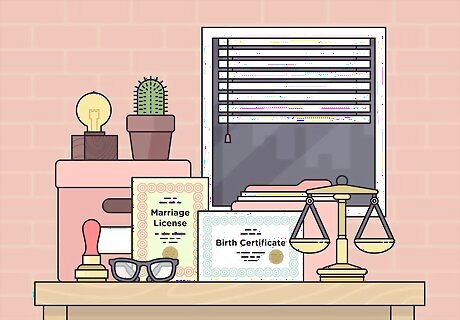
views
Assessing Which Visa You Need

Apply for a Schengen visa if you’re visiting Spain as a tourist from a non-Schengen country. If you’re going to spend fewer than 90 days in Spain and are a citizen of a country that is a member of the Schengen agreement, you do not need to apply for a visa to visit Spain. Nearly all countries in North America and Europe are part of the Schengen agreement. If you live in Africa or Asia, however, you’ll need to apply for a Schengen visa, since most African and Asian countries are not members of the Schengen agreement.

Get a long-term visa if you’ll be in Spain for longer than 90 days. If you’re going to work in Spain, or if you’re planning to study abroad in Spain for a full semester or year, the government requires you to obtain a long-term visa. Long-term visas are broken down into 3 categories: student visas (if you’ll be studying in Spain), residence visas (if you’re traveling to live in Spain or to visit family), and combined residence/work visas. Combined residence/work visas allow you to live and work in Spain for an extended period of time. If you’re applying for a residence/work visa, you’ll need to show a copy of your employment contract to the clerk at the Spanish consulate when you apply for a visa. Citizens of the European Union (EU) or of Switzerland do not need a long-term visa to spend more than 90 days in Spain.

Use an airport transit visa to enter Spanish airports. More specifically, holders of an airport travel visa are legally authorized to spend time in the international transit zone in an airport. You’ll need this visa if you’re changing planes in an airport in Spain but aren’t planning to set foot outside of the airport. You will need to provide the specific dates and times that you’ll be entering and leaving Spanish airports when you apply for the visa. Not everyone needs to apply for an airport visa to enter the international transit zones. To find out if citizens of your country need to, check online at: http://www.exteriores.gob.es/Portal/es/ServiciosAlCiudadano/InformacionParaExtranjeros/Documents/Listado%20II.pdf.
Gathering Visa Application Materials

Have a 35 mm × 45 mm (1.4 in × 1.8 in) passport photo of yourself taken. You can either take the photo yourself or visit a local post office or other public building for the passport photo. The photograph should feature your entire face looking straight into the camera. Make sure to maintain a neutral expression while the photo is being taken. If you’re taking the photograph yourself, stand in front of a light-colored background and make sure that your face fills 70–80% of the photo. You will need 2 copies of this photo when you apply for your Spanish visa. If you do not have a passport already, you’ll need 1 copy of the photo to apply for the passport.

Apply for and obtain a passport from the country where you live. Before you get a visa, you must hold a non-expired passport. If you live in the U.S., the first step will be filling out a form DS-11 (if you’ve never had a passport before) or a form DS-82 (if you’re an adult renewing a passport). Gather proof of citizenship (e.g., a birth certificate) and proof of identity (e.g., a state-issued ID card). Take these documents—along with a 2 in × 2 in (5.1 cm × 5.1 cm) color photograph of yourself—to the nearest passport-processing facility. Many public buildings—including libraries and post offices—can process passport applications. To find the one nearest you, type in your ZIP code at: https://iafdb.travel.state.gov/. Find either type of passport renewal form online at: https://travel.state.gov/content/travel/en/passports/requirements/forms.html.

Download and fill out a copy of the Spanish visa application. Applicants for a Spanish Schengen visa must fill out a 37-question visa form. Print a blank copy of the form and write your answers in blue or black ink. Write your name, date of birth, nationality, and gender, then clarify the type of visa that you are applying for (i.e., Schengen, long-term, or airport). Specify the country that you’re a citizen of, and write your passport number. Finish up the form by briefly describing the reason for your stay and signing the application. Find the application form for a Schengen visa online at: https://www.schengenvisainfo.com/download-schengen-visa-application-form/. Access a copy of the long-term visa application online at: https://ph.blsspainvisa.com/pdf/longstay-schengen_visa_application_form_english.pdf. Pick up a paper copy of the airport transit visa application from the Spanish Consulate Office at which you plan to file the application.

Buy airline tickets to Spain 2–3 months in advance of your trip. It would be wise to start looking for international flight tickets as early as 4 months prior to when you plan to head to Spain. Not only will this save you money on the tickets themselves, but you’ll have official documentation of your travel plans in-hand well before you travel. Check for tickets on travel-booking websites or directly from the airlines’ websites. Popular international airlines that fly to Spain include Delta, United, Norwegian, Air Europa, Iberia, and American Airlines.

Purchase Spain Travel Insurance for at least 30,000€. The country of Spain requires visa holders to be insured in case you are injured or develop any medical conditions during your stay in the country. The insurance that you purchase must be valid within the entire Schengen area. This includes all of Europe. The 2 main providers of Spain Travel Insurance are AXA Assistance and Europe Assistance. While insurance rates vary, you can generally insure your travel for about 1–3€ ($1.11–3.33 USD) per day. Learn more and purchase assistance through AXA Assistance at: https://www.axa-schengen.com/en?utm_source=schengenvisainfo&utm_medium=partnership&utm_campaign=en_home_schengenvisainfo_redirect. Purchase Spain Travel Insurance through Europ Assistance at: https://schengen.europ-assistance.com/en?ipc=svien&utm_source=schengenvisainfo&utm_medium=affiliates&utm_campaign=svien. Not only is Spain Travel Insurance required when applying for a Schengen visa, but you’ll also be required to show proof of insurance when you arrive at a Spanish port of entry. Currency exchange rates can fluctuate from month to month. However, 30,000€ is currently worth about $33,311 USD.

Write a cover letter that explains your purpose for visiting Spain. Explain why you’re visiting Spain (e.g., to tour the country, to visit friends, to study, or to work) and how you’re planning to pay for expenses generated while you’re traveling. Also give an overview of your expected itinerary, including which cities or regions you’ll be visiting and for how long. Finally, if your visit is being sponsored (e.g., by a university or host family), explain your relationship to the sponsor. The length of your cover letter will vary based on the complexity of your reasons for traveling to Spain. As a broad rule of thumb, though, the letter should be 100–150 words long, plus a bullet-point itinerary. It shouldn’t be very detailed; describe your travel plans broadly. If you’d like to look at sample cover letters that you can model yours after, visit: https://www.schengenvisainfo.com/application-cover-letter/.
Filing Your Visa Application

Make an appointment at the Spanish consulate nearest to your home. All types of visa applications must be filed in person at a Spanish Consulate that’s located in your country of residence. Bring with you your completed visa application, cover letter, and proof of Spanish Travel Insurance. Visit the office at least 90 days before you plan to begin your trip to Spain to ensure that your visa will be processed by the time you depart. To ensure that you can get an appointment at a time that’s convenient to you, schedule it at least 2 weeks in advance. If you live in the U.S. and you’re not sure where the nearest Spanish Consulate Office is to you, look online at: http://www.exteriores.gob.es/Embajadas/WASHINGTON/en/Embajada/Pages/inicio.aspx. Each of the Spanish Consulate Offices has its own website. Look online to find the site and use its appointment portal to book your appointment.

Bring a photocopy of your return ticket reservation to your home country. When you apply for a Schengen visa, the Spanish government requires confirmation that you have already purchased transportation to return home. The return tickets should be dated within 90 days of when you’re entering Spain. It’s most common to include a photocopy of an airline ticket. However, if you live in a country that borders Spain, you could also include a photocopy of a bus or rail ticket. If you’ll be in Spain on a non-Schengen visa for longer than 90 days, you may not be required to show proof of return tickets.

Show proof of residence if you’ll be staying in a hotel or hostel. When you apply for a Spanish Schengen visa, you’ll need to show the government that you’ve already made arrangements for where you’ll be staying overnight. If you’ll be in hotels or hostels, reserve the rooms in advance for the entire duration of your trip. When you apply for the visa, show the clerk the receipts that document where you’ll be staying. If you’ll be staying with friends and family in Spain, bring a signed letter or email stating the dates you’ll be staying at the residence. If you’re applying for a long-term visa, you do not need to show proof of residence, since you will likely not be staying in a hotel.

Give proof that you have the financial means to support your travel. The Spanish government wants to ensure that visa holders do not run out of money while in Spain and become stranded in the country. Show a bank statement that proves that you have more than 90% of the gross national minimum wage for a stay of 10 days or fewer. Numerically, this means that you must have at least 584€ ($648 USD) in your account. If you’ll be staying for longer than 10 days, you must have at least 65€ ($72 USD) in your bank account for every day you’ll spend in Spain.

Provide legal proof of your civil status. If you are married—whether or not your spouse is traveling with you—you must present a copy of your marriage license when you apply for a Spanish visa. Similarly, show copies of your children’s birth certificates if you have children. Finally, if you were once married but your spouse passed away, the Spanish government requires you to show a copy of the death certificate. If you have never been married and have no children, this step does not apply to you.


















Comments
0 comment